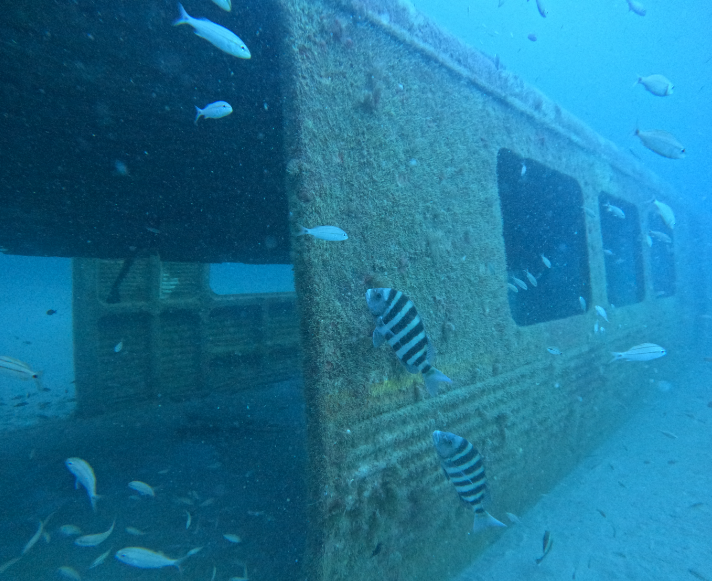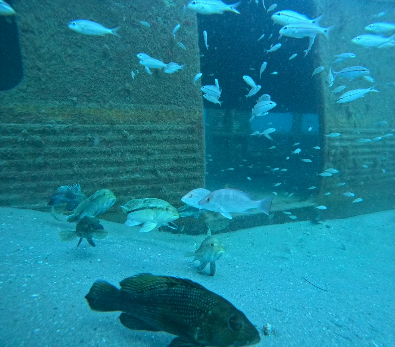What was once a bustling hub of commuter activity has now become a thriving underwater sanctuary. Two retired subway cars from the Metropolitan Atlanta Rapid Transit Authority (MARTA) have been repurposed to create new habitats for marine life at the bottom of the Atlantic Ocean. This innovative initiative not only helps protect the environment but also gives a second life to these iconic pieces of Atlanta’s history.
From City Streets to Ocean Depths: The Journey of Atlanta’s Subway Cars
For years, these MARTA railcars shuttled commuters, families, and tourists across Atlanta. Now, they’ve traded in their urban environment for a new home beneath the waves, where they provide shelter and breeding grounds for a variety of fish and other marine species.
“The artificial reef is looking great, and we are encouraged by the amount of coral growth and marine wildlife activity,” says Cameron Brinton, a marine biologist with Georgia’s Department of Natural Resources Coastal Resources Division.
Georgia’s Coastal Resources Division has been dedicated to enhancing marine habitats through artificial reefs for over 40 years. The coastal seafloor, which is largely composed of sand and shells, doesn’t naturally support reef formation. To remedy this, the division has used man-made structures like bridge supports, sunken ships, concrete rubble, and now, retired subway cars, to create essential habitats for marine life.

The Making of an Artificial Reef: Atlanta Subway Cars Dive In
The decision to repurpose Atlanta’s decommissioned subway cars into artificial reefs was both an environmentally conscious move and a practical solution for disposal. “This seemed like a real, tangible thing we could do to promote sustainability,” says Thomas Worthy, former chairman of the MARTA Board of Directors. He notes that turning the railcars into reefs is also an ideal method for their disposal.
Before the cars could be submerged, the Coastal Resources Division and MARTA collaborated to ensure they were free of hazardous materials and contaminants. In December, they began preparing the 72-foot-long railcars, selecting deployment locations that would benefit marine life while avoiding any interference with natural habitats or shipping lanes.
After receiving clearance from the U.S. Coast Guard, the railcars were loaded onto a barge and transported to a site known as “L Reef,” about 23 nautical miles from Georgia’s Ossabaw Island. There, the 55,000-pound cars were carefully lowered into the ocean, where they gently sank to the seafloor.
L Reef: A Growing Underwater Community
L Reef, established in 1976, spans approximately four square miles and lies 55 to 65 feet below the ocean’s surface. This underwater sanctuary already hosts an array of man-made structures, including New York City subway cars, barges, tugboats, U.S. Army M-60 battle tanks, and over 1,000 tons of concrete culvert pipe. The addition of Atlanta’s subway cars is just the latest chapter in this ongoing effort to support marine life along Georgia’s coast.

Last month, divers visited the site to assess the impact of the newly added railcars. They reported seeing at least nine species of game fish and noted the early stages of coral growth. One of the railcar roofs had collapsed—a common occurrence as these structures adapt to their new underwater environment and become fully integrated into the marine habitat.
“The reefs are evolving beautifully,” says Daniel Gleason, a marine ecologist at Georgia Southern University. “The diversity of life we’re seeing rivals that of natural coral reefs.”
Looking Ahead: More Subway Cars to Join the Reef
The success of this project has prompted plans to add up to six more retired Atlanta subway cars to the artificial reef in the near future. MARTA is in the process of rolling out 254 new railcars, which means more decommissioned cars will become available for repurposing. Instead of being sold for scrap, these old cars are finding a new purpose—contributing to marine conservation.
Collie Greenwood, chief executive officer and general manager of MARTA, expresses pride in the city’s efforts to recycle the old cars in such an environmentally responsible way. “We’re proud to give these railcars a second life as part of an important marine habitat,” he says. “As we continue to upgrade our fleet, we hope to provide even more retired cars for reef deployment.”
The Environmental Impact: A Win for Sustainability
The transformation of Atlanta’s old subway cars into thriving marine habitats is a powerful example of how cities can creatively repurpose outdated infrastructure for environmental good. These artificial reefs not only support biodiversity but also provide valuable opportunities for recreational activities like fishing and diving.
Artificial reefs have long been recognized for their ability to enhance local ecosystems. By creating new habitats in areas where natural reefs are scarce, they help sustain fish populations and promote coral growth. Moreover, these reefs serve as living laboratories for scientists studying marine life and the impacts of human-made structures on underwater ecosystems.
Conclusion: Breathing New Life into Old Railcars
Atlanta’s innovative approach to repurposing its retired subway cars is a testament to the city’s commitment to sustainability and environmental stewardship. What once served as a vital part of the city’s public transportation system now plays an equally important role in preserving marine life off the coast of Georgia. As more decommissioned railcars make their way to the ocean floor, these artificial reefs will continue to grow, providing essential habitats for countless species and supporting the health of our oceans.
FAQs
1. Why were Atlanta’s subway cars turned into artificial reefs?
The decommissioned subway cars were repurposed to create artificial reefs, providing essential habitats for marine life and promoting sustainability.
2. What is L Reef, and where is it located?
L Reef is an artificial reef site located about 23 nautical miles off Georgia’s Ossabaw Island. It spans four square miles and lies 55 to 65 feet below the ocean’s surface.
3. How do artificial reefs benefit marine life?
Artificial reefs provide shelter and breeding grounds for marine species, helping to sustain fish populations and promote coral growth in areas where natural reefs are scarce.
4. What other structures are part of L Reef?
L Reef hosts a variety of man-made structures, including New York City subway cars, barges, tugboats, U.S. Army M-60 battle tanks, and concrete culvert pipes.
5. Will more Atlanta subway cars be added to the artificial reef?
Yes, up to six additional retired subway cars from Atlanta are expected to be added to the artificial reef in the future as MARTA continues to upgrade its fleet.